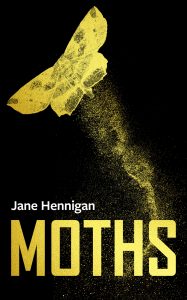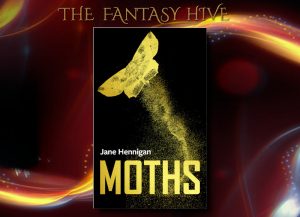MOTHS by Jane Hennigan (COVER REVEAL and INTERVIEW)
Today, we’re super excited to be taking part in Angry Robot’s cover reveal for Jane Hennigan’s MOTHS!
Moths is a feminist dystopia originally self-published by Hennigan, now republished by Angry Robot and expected for release in March 2023. Want to know more about it? Here’s the official blurb:
Forty years ago, the world changed. Toxic threads left behind by mutated moths infected every man and boy, killing them quietly in their sleep, or turning them into crazed killers. No one was safe from their psychopathic wrath and no one could reach them. All seemed hopeless.
But humanity, as it does, adapted and society moved on. Now, men are kept in specially treated dust-free facilities for their safety, and are never able to return to the outside. The world is quiet, but secrets are kept safe in whispers. Very few people remember what life was like before the change, but Mary knows. She had a family. She was happy. This is her story.
Exploring male violence against women, homo-normativity, and gynocracy, Moths is a powerful assessment of life through the lens of a main character in her 70s.

Jane Hennigan: “I devour any and all dystopian fiction, especially feminist dystopias, so when I read an article on a type of toxic caterpillar infesting Europe, I put the two together and the idea for Moths was formed. I wanted my protagonist to be an older woman, flawed but capable, and constantly underestimated by those close to her. I put my book out there with few expectations and was stunned by the overwhelming response from so many readers. This past year, Moths has taken on a life of its own, and I’m delighted that Angry Robot has stepped in to ensure Mary’s story reaches the widest readership possible. ”
Mushens Entertainment Agent, Liza DeBlock: “I am absolutely delighted that Angry Robot will be publishing Jane’s engaging, harrowing, and inspiring novel, Moths. I cannot think of a better partnership to bring this wonderful book to readers.”
Publisher, Eleanor Teasdale: “Moths is utterly, horrifyingly compelling with an older protagonist who has lived through the change in the world. It’s smart, readable and a total breakout sensation. I’m so excited to introduce Moths to a whole new set of readers as well as get the magnificent sequel, Toxxic, to the fans who picked it up early on.”
Managing Editor, Gemma Creffield: “I have been looking for a book that shook me as much as The Power for a long time, so I was so pleased to come across Moths. Jane’s duology fits the bill entirely!”
We were fortunate to get to chat to Jane about Moths:
Hi Jane, and welcome to the Hive. We’re so excited to be taking part in your cover reveal!
It’s certainly a striking, eye-catching cover, which really draws attention to the importance of the dust.
Was this something you were hoping they’d focus on in the design?
Thank you for having me! I had some quite fixed ideas on what I thought the cover should be when we started–for example, it had to involve the colour red! However, the art department at Angry Robot came up with this design and I just fell in love with it. I abandoned any pretence of knowing what would work best and allowed them to do their job. I love the contrast of the gold and the black, and how eerie the moth looks. They’ve done an amazing job.
What five words would you use to describe Moths?
Dystopian, Disturbing, Disruptive, Compelling, Creepy
Let’s delve beneath the cover and into your dystopia. You’ve talked about being influenced by feminist dystopias, and also an article about a toxic caterpillar? Can you tell us more about how these two things merged into Moths?
I wanted to imagine and write about a society that wasn’t governed by men and to escape preconceived notions of hetero normativity and feminine essentialism. So, I needed a vehicle to get rid of the vast majority of men for an extended period of time. I considered a disease, but I wanted it to be fast-moving and airborne, surrounding the world in days rather than weeks. Then I saw the article on the BBC about toxic caterpillars and began tentatively plotting out the story. As I wrote I leaned into the creepy reputation of moths to create atmosphere. I realised moths are perfect for this kind of dark storytelling – how they swarm around a light, how they sit dead still on surfaces as if lying in wait. There’s something about caterpillars that give me chills. The spiky hairs and the bright colours – it’s like an instinctive part of me screams don’t touch them!
Can you share with us some of your favourite feminist dystopias that might tempt our readers to pick up Moths?
Herland by Charlotte Perkins Gilman is the original FD – it’s a quick read and also funny. Atwood’s The Handmaid’s Tale is classic. It’s decidedly less funny, but beautiful and devastating and was a catalyst for my seventeen-year-old self to start to question the status quo. The Power, by Naomi Alderman elegantly switches the power dynamic. The recent novella series by Chimamanda Ngozi Adichie, beginning with The Visit, offers an entertaining depiction of a gynocracy. Not strictly a dystopia, but Ursula Le Guin’s Left Hand of Darkness had a huge impact on my views on gender. The Bees by Laline Paull – Ah, there are so so many…
You explore some big, and extremely topical, themes: male violence against women, homo-normativity, and gynocracy. How do you feel about continuing sci-fi’s great tradition of providing explorative terrain for current societal issues?
Similar to Atwood’s assertion in The Handmaid’s Tale, every act of male violence in Moths is taken from an actual incident. Research for this part of the novel was grim, and I spent much of this time furious. I think you can feel the rage in those scenes.
When writing the future timeline, it turned out that getting rid of the patriarchy is harder than just killing off the majority of men and locking the rest up in facilities and sanatoriums. The women carry the patriarchy with them – in their thoughts, behaviour, language, conditioning. I had to think hard about the legacy of the patriarchy. How long before new generations of woman escape the ghosts of their grandfathers? I tried to show a number of different female experiences as the world changed, Mary as a mother of a son, Olivia as a scared teenager, Claire as a trans woman mistreated by an indifferent system. SSF has a tradition of challenging norms to underscore unjust power structures in our own world. That’s a tradition in which I’m pleased to participate.
We need to talk about Mary! It would have been easy to write a young protagonist looking ahead to her life in your world of secrets; what drew you to an older, retrospective protagonist instead? (Aside from, of course, the need for more representation of older women in general!)
I knew at the start that my MC would be older. Older people are often underestimated, but these days many people are living action-packed, exciting lives into their eighties and beyond. That said, Mary is weary from the secrets she has been keeping and the way the world has changed. The idea of going out on a daring mission to save ‘mankind’ is utterly exhausting for her. There’s a moment, for example, when she’s crouched in a cupboard hiding from her enemies and she wonders if she’ll even be able to stand up again when they leave.
Another aspect of Mary’s character is her feeling of alienation from the younger women around her. I think this is something everyone feels at some point in their life, politics, technology, social norms, are changing so rapidly that your own ideas are becoming obsolete. The women Mary work with have never known what it’s like to walk down a street clutching a set of car keys like a weapon, or fall pregnant by accident. I think she envies their complacency.
Who else might we encounter in Moths? Tell us about your other characters?
Tony is my favourite character (are we allowed to have a favourite? Or is it like children where you have to hedge?) He’s cheerful and kind, despite being ground down by his lack of freedom, and the bullying of the mean ward-sister, Daisy. I was surprised to find that my favourite character ended up being a man, but there you go. All the male characters in the book lack agency. The men in the future, such as Tony and Cole, are characterised as naïve – not stupid by any means, but undereducated and cloistered.
Finally, what is the one thing you hope readers take away from your writing?
Cliched perhaps, but – a talking point? How would a country of women, cut off from the old world economies, design a society? How would they treat the men in their care? How would men have acted if the toxin had affected women?
Thank you so much for joining us today!
Thank you so much!

